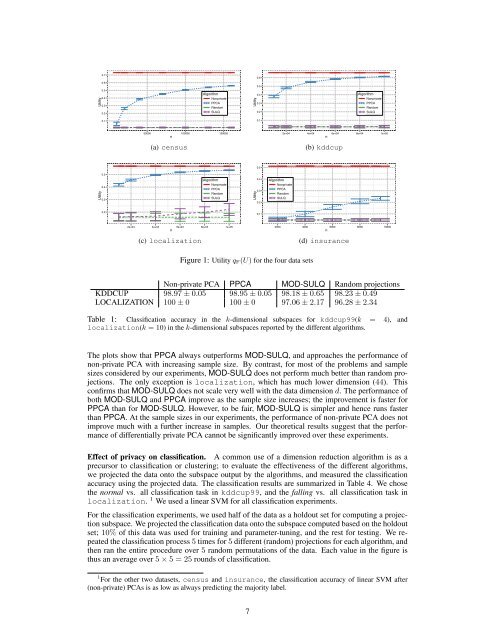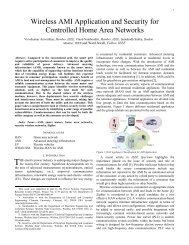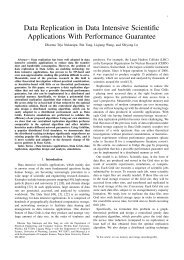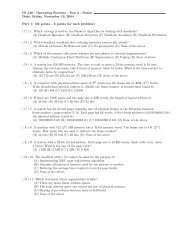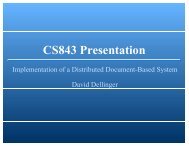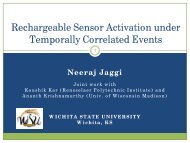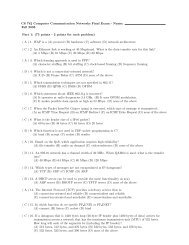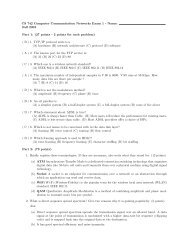Near-optimal Differentially Private Principal Components - NIPS
Near-optimal Differentially Private Principal Components - NIPS
Near-optimal Differentially Private Principal Components - NIPS
You also want an ePaper? Increase the reach of your titles
YUMPU automatically turns print PDFs into web optimized ePapers that Google loves.
0.70.60.60.5Utility0.50.40.3AlgorithmNonprivatePPCARandomUtility0.40.3AlgorithmNonprivatePPCARandom0.2SULQ0.2SULQ0.10.150000 100000 150000n2e+04 4e+04 6e+04 8e+04 1e+05n(a) census(b) kddcup0.50.5Utility0.40.3AlgorithmNonprivatePPCARandomSULQUtility0.40.30.2AlgorithmNonprivatePPCARandomSULQ0.20.12e+04 4e+04 6e+04 8e+04 1e+05n2000 4000 6000 8000 10000n(c) localization(d) insuranceFigure 1: Utility q F(U) for the four data setsNon-private PCA PPCA MOD-SULQ Random projectionsKDDCUP 98.97 ± 0.05 98.95 ± 0.05 98.18 ± 0.65 98.23 ± 0.49LOCALIZATION 100 ± 0 100 ± 0 97.06 ± 2.17 96.28 ± 2.34Table 1: Classification accuracy in the k-dimensional subspaces for kddcup99(k = 4), andlocalization(k =10) in the k-dimensional subspaces reported by the different algorithms.The plots show that PPCA always outperforms MOD-SULQ, and approaches the performance ofnon-private PCA with increasing sample size. By contrast, for most of the problems and samplesizes considered by our experiments, MOD-SULQ does not perform much better than random projections.The only exception is localization, which has much lower dimension (44). Thisconfirms that MOD-SULQ does not scale very well with the data dimension d. The performance ofboth MOD-SULQ and PPCA improve as the sample size increases; the improvement is faster forPPCA than for MOD-SULQ. However, to be fair, MOD-SULQ is simpler and hence runs fasterthan PPCA. At the sample sizes in our experiments, the performance of non-private PCA does notimprove much with a further increase in samples. Our theoretical results suggest that the performanceof differentially private PCA cannot be significantly improved over these experiments.Effect of privacy on classification. A common use of a dimension reduction algorithm is as aprecursor to classification or clustering; to evaluate the effectiveness of the different algorithms,we projected the data onto the subspace output by the algorithms, and measured the classificationaccuracy using the projected data. The classification results are summarized in Table 4. We chosethe normal vs. all classification task in kddcup99, and the falling vs. all classification task inlocalization. 1 We used a linear SVM for all classification experiments.For the classification experiments, we used half of the data as a holdout set for computing a projectionsubspace. We projected the classification data onto the subspace computed based on the holdoutset; 10% of this data was used for training and parameter-tuning, and the rest for testing. We repeatedthe classification process 5 times for 5 different (random) projections for each algorithm, andthen ran the entire procedure over 5 random permutations of the data. Each value in the figure isthus an average over 5 ⇥ 5 = 25 rounds of classification.1 For the other two datasets, census and insurance, the classification accuracy of linear SVM after(non-private) PCAs is as low as always predicting the majority label.7


